2007 江苏考研英语一真题及答案
Section I
Directions:
Use of English
Read the following text. Choose the best word(s) for each numbered blank and mark
[A], [B], [C] or [D] on ANSWER SHEET 1. (10 points)
By 1830 the former Spanish and Portuguese colonies had become independent nations.
The roughly 20 million ___1___ of these nations looked ___2___ to the future. Born
in the crisis of the old regime and Iberian Colonialism, many of the leaders of
independence ___3___ the ideals of representative government, careers ___4___ to
talent, freedom of commerce and trade, the ___5___ to private property, and a belief
in the individual as the basis of society. ___6___ there was a belief that the new
nations should be sovereign and independent states, large enough to be economically
viable and integrated by a ___7___ set of laws.
On the issue of ___8___ of religion and the position of the church, ___9___, there
was less agreement ___10___ the leadership. Roman Catholicism had been the state
religion and the only one ___11___ by the Spanish crown. ___12___ most leaders sought
to maintain Catholicism ___13___ the official religion of the new states, some sought
to end the ___14___ of other faiths. The defense of the Church became a rallying
___15___ for the conservative forces.
The ideals of the early leaders of independence were often egalitarian, valuing
equality of everything. Bolivar had received aid from Haiti and had ___16___ in
return to abolish slavery in the areas he liberated. By 1854 slavery had been
abolished everywhere except Spain’s ___17___ colonies. Early promises to end Indian
tribute and taxes on people of mixed origin came much ___18___ because the new nations
still needed the revenue such policies ___19___. Egalitarian sentiments were often
tempered by fears that the mass of the population was ___20___ self-rule and
democracy.
1.
[A] natives
[B] inhabitants
[C] peoples
[D] individuals
2.
[A] confusedly
�
[B] cheerfully
[C] worriedly
[D] hopefully
3.
[A] shared
[B] forgot
[C] attained
[D] rejected
4.
[A] related
[B] close
[C] open
[D] devoted
5.
[A] access
[B] succession
[C] right
[D] return
6.
[A] Presumably
[B] Incidentally
[C] Obviously
[D] Generally
7.
[A] unique
[B] common
[C] particular
�
[D] typical
8.
[A] freedom
[B] origin
[C] impact
[D] reform
9.
[A] therefore
[B] however
[C] indeed
[D] moreover
10.
[A] with
[B] about
[C] among
[D] by
11.
[A] allowed
[B] preached
[C] granted
[D] funded
12.
[A] Since
[B] If
[C] Unless
[D] While
13.
[A] as
�
[B] for
[C] under
[D] against
14.
[A] spread
[B] interference
[C] exclusion
[D] influence
15.
[A] support
[B] cry
[C] plea
[D] wish
16.
[A] urged
[B] intended
[C] expected
[D] promised
17.
[A] controlling
[B] former
[C] remaining
[D] original
18.
[A] slower
[B] faster
[C] easier
�
[D] tougher
19.
[A] created
[B] produced
[C] contributed
[D] preferred
20.
[A] puzzled by
[B] hostile to
[C] pessimistic about
[D] unprepared for
Reading Comprehension
Section II
Part A
Directions:
Read the following four texts. Answer the questions below each text by choosing [A],
[B], [C], or [D]. Mark your answers on ANSWER SHEET 1. (40 points)
Text 1
If you were to examine the birth certificates of every soccer player in 2006’s World
Cup tournament, you would most likely find a noteworthy quirk: elite soccer players
are more likely to have been born in the earlier months of the year than in the later
months. If you then examined the European national youth teams that feed the World
Cup and professional ranks, you would find this strange phenomenon to be even more
pronounced.
a) certain
What might account for this strange phenomenon? Here are a few guesses:
b) winter-born babies tend to
astrological signs confer superior soccer skills;
c) soccer-mad
have higher oxygen capacity, which increases soccer stamina;
parents are more likely to conceive children in springtime, at the annual peak of
soccer mania;
d) none of the above.
Anders Ericsson, a 58-year-old psychology professor at Florida State University,
says he believes strongly in “none of the above.” Ericsson grew up in Sweden, and
studied nuclear engineering until he realized he would have more opportunity to
conduct his own research if he switched to psychology. His first experiment, nearly
30 years ago, involved memory: training a person to hear and then repeat a random
�
series of numbers. “With the first subject, after about 20 hours of training, his
digit span had risen from 7 to 20,” Ericsson recalls. “He kept improving, and after
about 200 hours of training he had risen to over 80 numbers.”
This success, coupled with later research showing that memory itself is not
genetically determined, led Ericsson to conclude that the act of memorizing is more
of a cognitive exercise than an intuitive one. In other words, whatever inborn
differences two people may exhibit in their abilities to memorize, those differences
are swamped by how well each person “encodes” the information. And the best way
to learn how to encode information meaningfully, Ericsson determined, was a process
known as deliberate practice. Deliberate practice entails more than simply repeating
a task. Rather, it involves setting specific goals, obtaining immediate feedback
and concentrating as much on technique as on outcome.
Ericsson and his colleagues have thus taken to studying expert performers in a w
ide range of pursuits, including soccer. They gather all the data they can, not just
performance statistics and biographical details but also the results of their own
laboratory experiments with high achievers. Their work makes a rather startling
assertion: the trait we commonly call talent is highly overrated. Or, put another
way, expert performers – whether in memory or surgery, ballet or computer
programming – are nearly always made, not born.
21.
The birthday phenomenon found among soccer players is mentioned to
[A] stress the importance of professional training.
[B] spotlight the soccer superstars in the World Cup.
[C] introduce the topic of what makes expert performance.
[D] explain why some soccer teams play better than others.
22.
The word “mania” (Line 4, Paragraph 2) most probably means
[A] fun.
[B] craze.
[C] hysteria.
[D] excitement.
23.
According to Ericsson, good memory
[A] depends on meaningful processing of information.
�
[B] results from intuitive rather than cognitive exercises.
[C] is determined by genetic rather than psychological factors.
[D] requires immediate feedback and a high degree of concentration.
24.
Ericsson and his colleagues believe that
[A] talent is a dominating factor for professional success.
[B] biographical data provide the key to excellent performance.
[C] the role of talent tends to be overlooked.
[D] high achievers owe their success mostly to nurture.
Which of the following proverbs is closest to the message the text tries to
25.
convey?
[A] “Faith will move mountains.”
[B] “One reaps what one sows.”
[C] “Practice makes perfect.”
[D] “Like father, like son.”
Text 2
For the past several years, the Sunday newspaper supplement Parade has featured a
column called “Ask Marilyn.” People are invited to query Marilyn vos Savant, who
at age 10 had tested at a mental level of someone about 23 years old; that gave her
an IQ of 228 – the highest score ever recorded. IQ tests ask you to complete verbal
and visual analogies, to envision paper after it has been folded and cut, and to
deduce numerical sequences, among other similar tasks. So it is a bit confusing when
vos Savant fields such queries from the average Joe (whose IQ is 100) as, What’
s the difference between love and fondness? Or what is the nature of luck and
coincidence? It’s not obvious how the capacity to visualize objects and to figure
out numerical patterns suits one to answer questions that have eluded some of the
best poets and philosophers.
Clearly, intelligence encompasses more than a score on a test. Just what does it
mean to be smart? How much of intelligence can be specified, and how much can we
learn about it from neurology, genetics, computer science and other fields?
�
The defining term of intelligence in humans still seems to be the IQ score, even
though IQ tests are not given as often as they used to be. The test comes primarily
in two forms: the Stanford-Binet Intelligence Scale and the Wechsler Intelligence
Scales (both come in adult and children’s version). Generally costing several
hundred dollars, they are usually given only by psychologists, although variations
of them populate bookstores and the World Wide Web. Superhigh scores like vos Savant’
s are no longer possible, because scoring is now based on a statistical population
distribution among age peers, rather than simply dividing the mental age by the
chronological age and multiplying by 100. Other standardized tests, such as the
Scholastic Assessment Test (SAT) and the Graduate Record Exam (GRE), capture the
main aspects of IQ tests.
Such standardized tests may not assess all the important elements necessary to
succeed in school and in life, argues Robert J. Sternberg. In his article “How
Intelligent Is Intelligence Testing?”, Sternberg notes that traditional test best
assess analytical and verbal skills but fail to measure creativity and practical
knowledge, components also critical to problem solving and life success. Moreover,
IQ tests do not necessarily predict so well once populations or situations change.
Research has found that IQ predicted leadership skills when the tests were given
under low-stress conditions, but under high-stress conditions, IQ was negatively
correlated with leadership – that is, it predicted the opposite. Anyone who has
toiled through SAT will testify that test-taking skill also matters, whether it`s
knowing when to guess or what questions to skip.
26.
Which of the following may be required in an intelligence test?
[A] Answering philosophical questions.
[B] Folding or cutting paper into different shapes.
[C] Telling the differences between certain concepts.
[D] Choosing words or graphs similar to the given ones.
27.
What can be inferred about intelligence testing from Paragraph 3?
[A] People no longer use IQ scores as an indicator of intelligence.
[B] More versions of IQ tests are now available on the Internet.
[C] The test contents and formats for adults and children may be different.
[D] Scientists have defined the important elements of human intelligence.
�
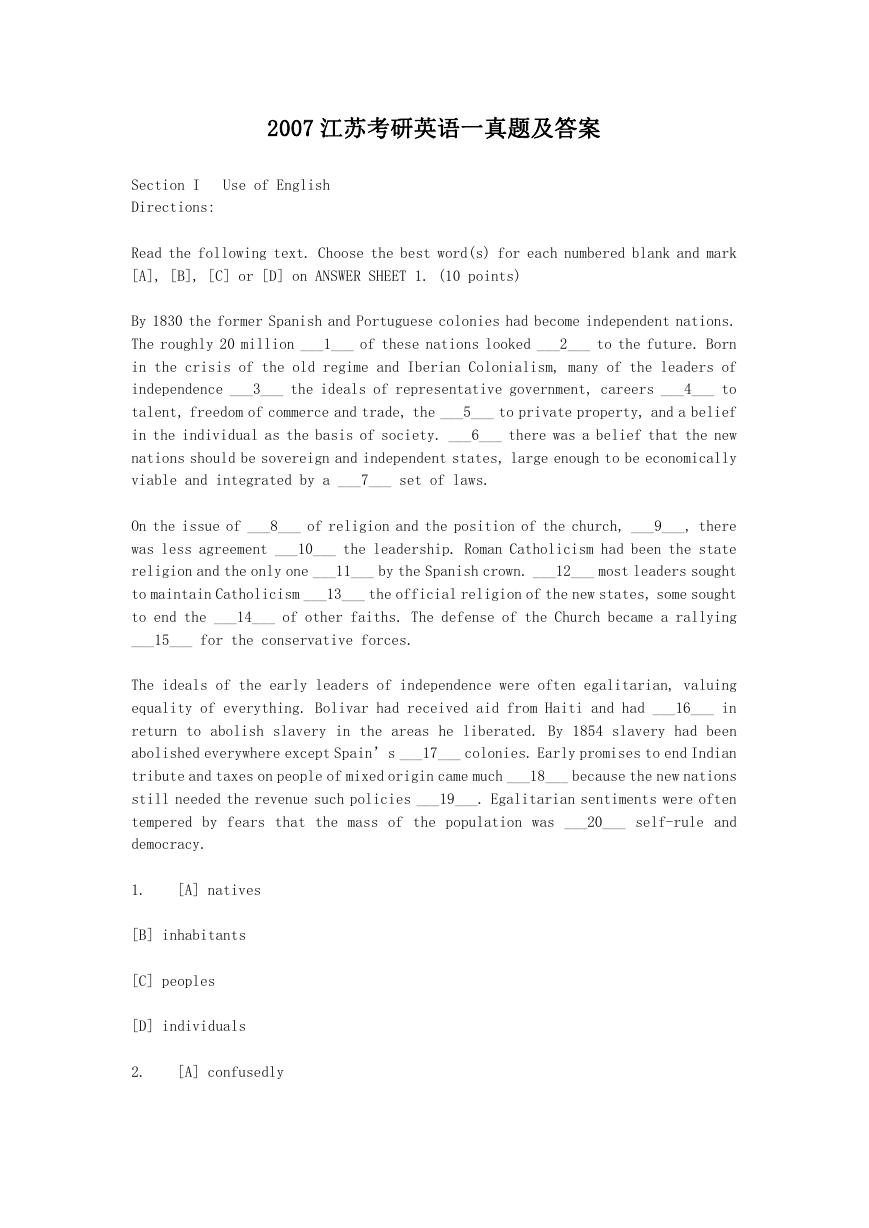

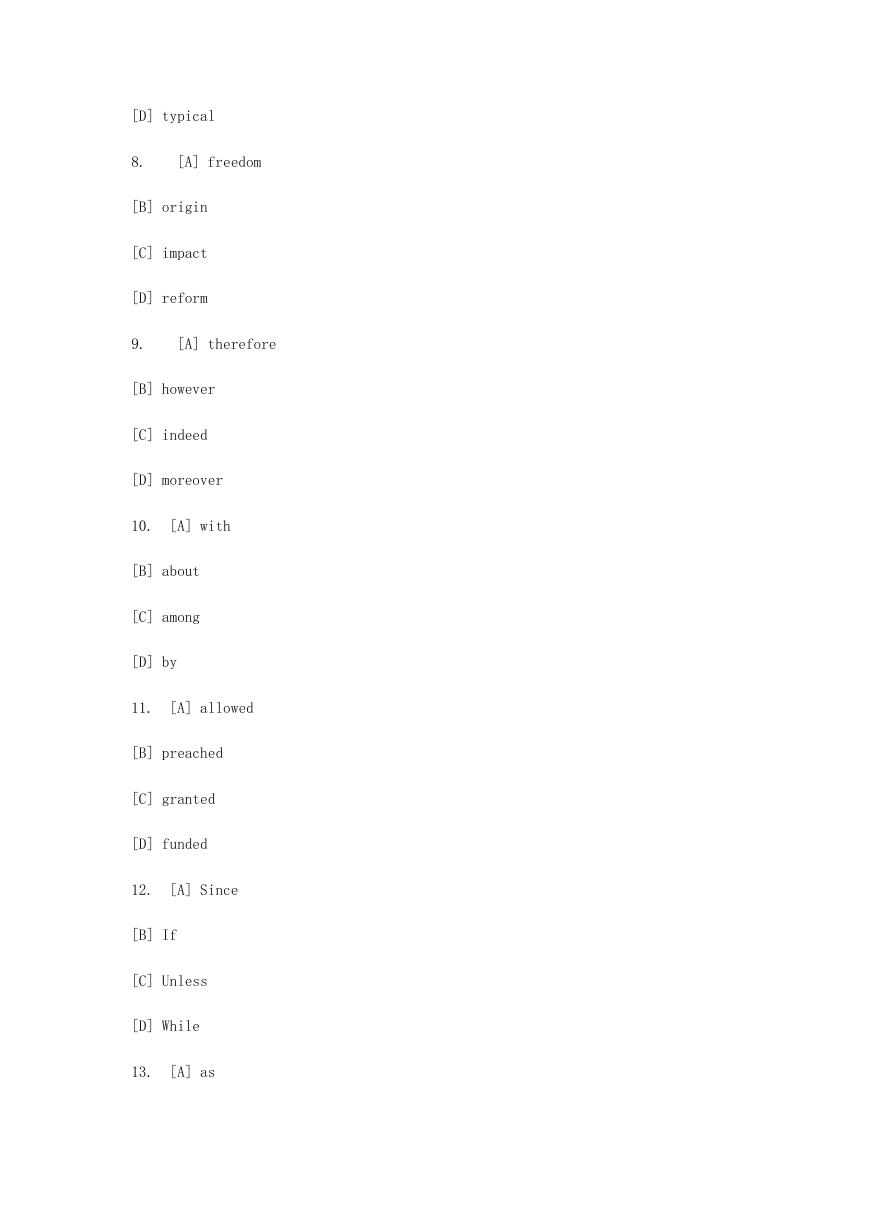

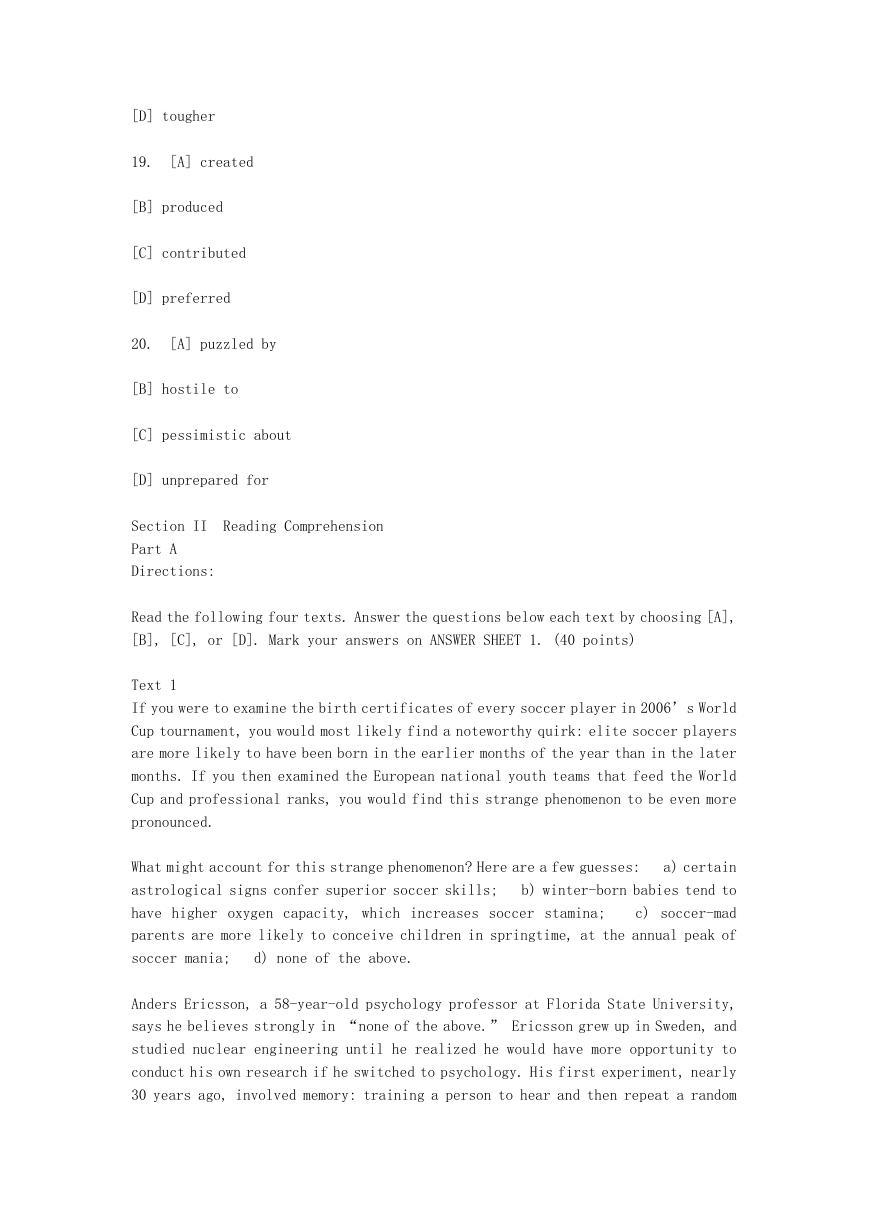
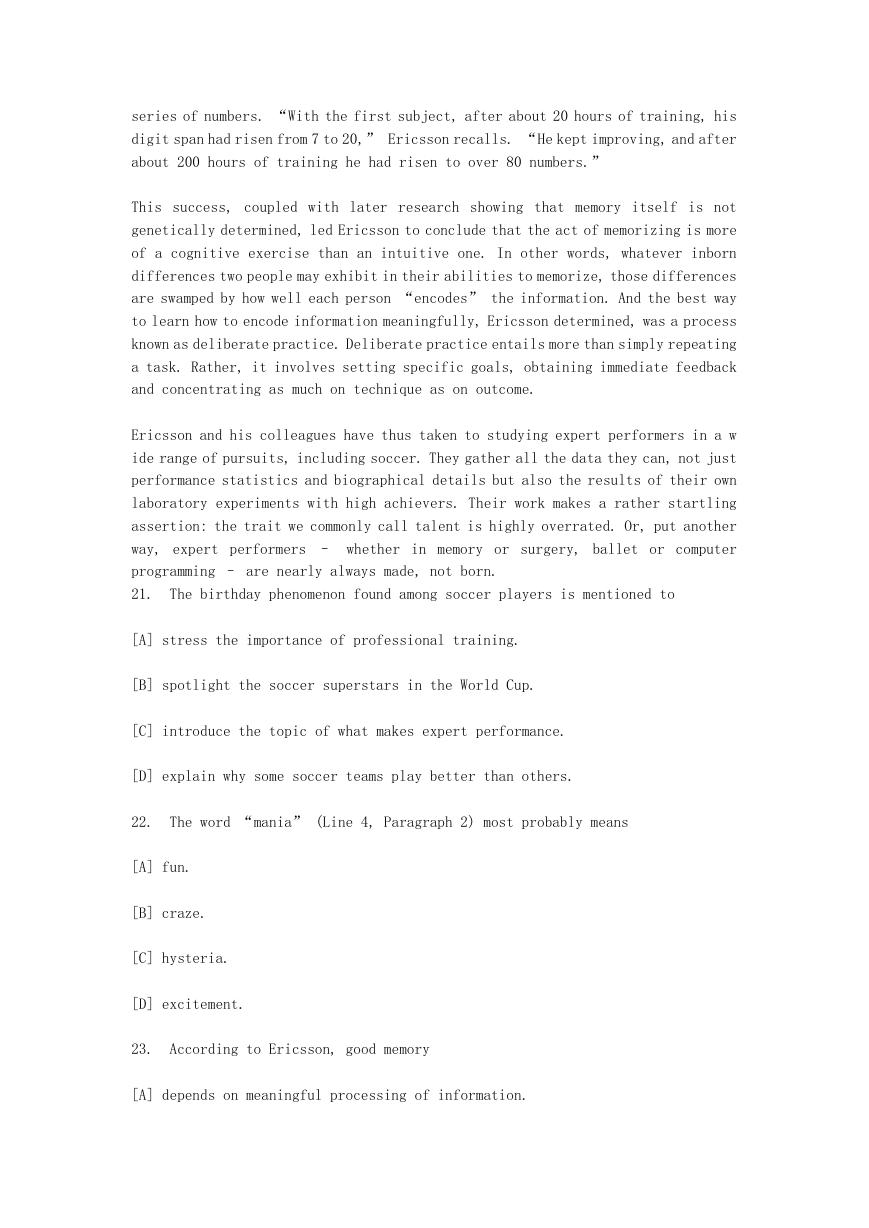

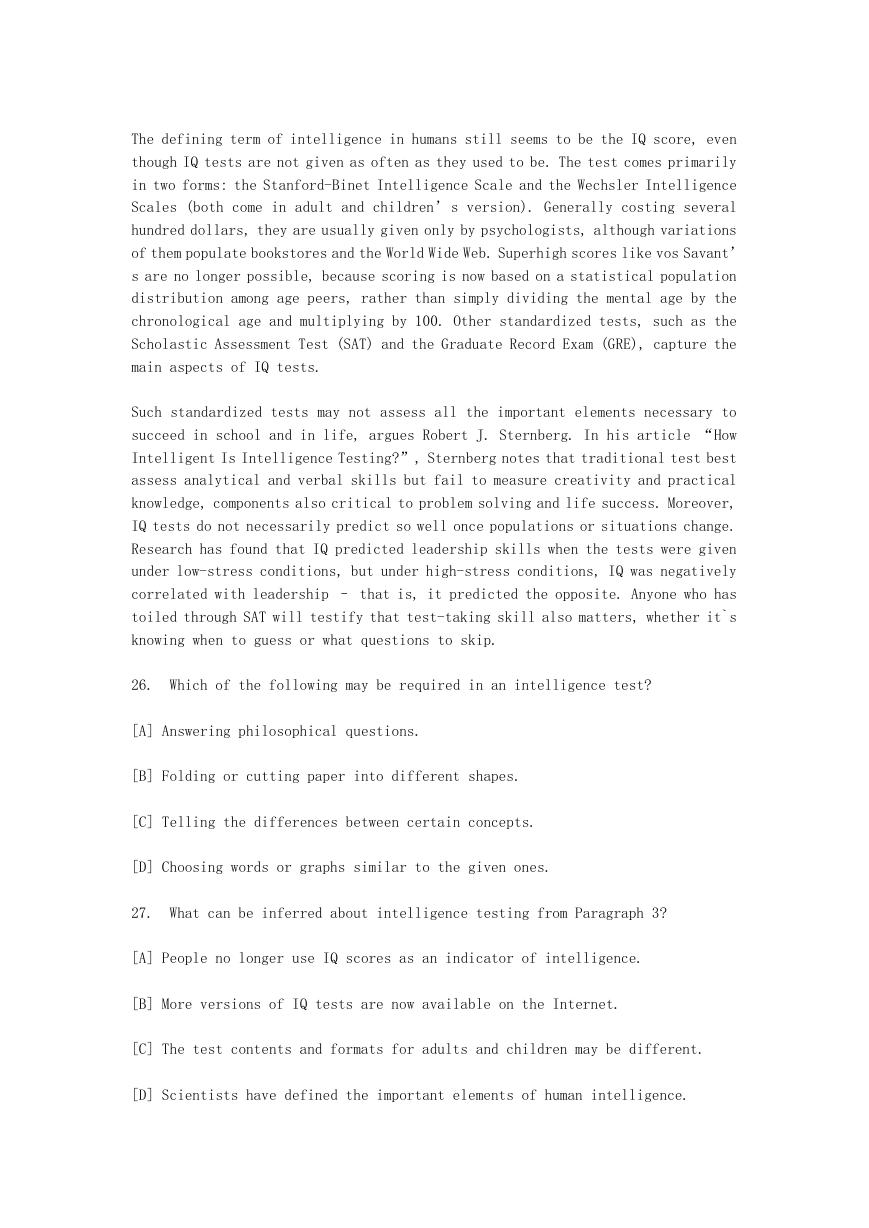








 2023年江西萍乡中考道德与法治真题及答案.doc
2023年江西萍乡中考道德与法治真题及答案.doc 2012年重庆南川中考生物真题及答案.doc
2012年重庆南川中考生物真题及答案.doc 2013年江西师范大学地理学综合及文艺理论基础考研真题.doc
2013年江西师范大学地理学综合及文艺理论基础考研真题.doc 2020年四川甘孜小升初语文真题及答案I卷.doc
2020年四川甘孜小升初语文真题及答案I卷.doc 2020年注册岩土工程师专业基础考试真题及答案.doc
2020年注册岩土工程师专业基础考试真题及答案.doc 2023-2024学年福建省厦门市九年级上学期数学月考试题及答案.doc
2023-2024学年福建省厦门市九年级上学期数学月考试题及答案.doc 2021-2022学年辽宁省沈阳市大东区九年级上学期语文期末试题及答案.doc
2021-2022学年辽宁省沈阳市大东区九年级上学期语文期末试题及答案.doc 2022-2023学年北京东城区初三第一学期物理期末试卷及答案.doc
2022-2023学年北京东城区初三第一学期物理期末试卷及答案.doc 2018上半年江西教师资格初中地理学科知识与教学能力真题及答案.doc
2018上半年江西教师资格初中地理学科知识与教学能力真题及答案.doc 2012年河北国家公务员申论考试真题及答案-省级.doc
2012年河北国家公务员申论考试真题及答案-省级.doc 2020-2021学年江苏省扬州市江都区邵樊片九年级上学期数学第一次质量检测试题及答案.doc
2020-2021学年江苏省扬州市江都区邵樊片九年级上学期数学第一次质量检测试题及答案.doc 2022下半年黑龙江教师资格证中学综合素质真题及答案.doc
2022下半年黑龙江教师资格证中学综合素质真题及答案.doc